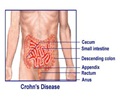Treatment plans aims at new target molecule discovered implicated in colon cancers
A molecule that is implicated in 85 percent of colon cancer (carcinoma) cases has been discovered by the Researchers at University of Utah's Huntsman Cancer Institute, which could be the possible target for treatment against colon cancers in the future.
Researchers were able to rescue zebra fish from the effects of a mutation in the adenomatous polyposis coli (APC) gene, by genetically disabling (undoing) a molecule called C-Terminal Binding Protein These findings appeared online published in the Journal of Biological Chemistry on October 6th 2006.Mutations in this gene have been known to trigger a series of reactions, which eventually give rise to colon polyps, which ultimately become cancerous. APC mutations play a role in 85% colon cancers. The new findings mean CTBP also is involved in that proportion of colon cancers.
In zebra fish, APC mutations keep the intestine from developing properly. "In essence, knocking out CTPB promotes normal development of the intestine in zebra fish carrying an APC mutation," says David A. Jones, a University of Utah associate professor of oncological sciences and leader of the study.
In normal cells of both humans and zebra fish, the APC gene controls the amount of CTBP present by marking it for destruction. In tumor cells with mutated APC, CTPB is not destroyed; instead it accumulates in the cell.
One function of CTBP is to turn off the process that converts vitamin A into retinoic acid in the cell. Retinoic acid is essential in cell differentiation – the function that determines what type of cell forms and how long it lives. This study observed that in both zebra fish and human tissues with APC mutations, there are high CTBP levels and low capability to produce retinoic acid. In APC-mutated tissues in which CTBP had been "knocked out," retinoic acid production was restored.
Earlier studies in Jones' lab showed that lack of retinoic acid caused zebra fish intestines to form incorrectly, and that adding retinoic acid corrected the problems.
Advertisement
Source-Eurekalert
SRM









